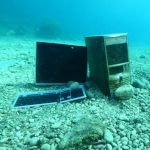And that’s all, I’m happy since I was out of space.
Is this a Linux version of windirstat?
There’s also QDirStat which is like KDirStat but without KDE dependencies.
There’s a more direct version of that, I guess from KDE, called KdirStat.
I hadn’t heard of the one in the op. But if I had to guess, it looks like it’s a different take on the same idea.
Omfg.
I was trying to remember the name of kdirstat ladt night when I stumbled across filelight and made use of that instead.
And now there’s a thread on this exact topic. Y’all need to quit it with all this Truman Show nonsense, Baader-Meinhof alone isn’t enough to explain how frequently shit like this happens. XD
Y’all need to quit it with all this Truman Show nonsense
Oh shit, he’s onto us!
Cheese it!
@EveryMuffinIsNowEncrypted @VonReposti Cheese? That’s a James May job.
😉🧀Lol, I love me some James May saying “cheese”, but I was more referring to the old Futurama episode where Bender goes back to Mars University. One of his signature catchphrases in that episode is “Cheese it!”
@EveryMuffinIsNowEncrypted Sorry I did not get this reference. I’m not a Futurama fan. I don’t know why. 🤷♂️
But I know BÄÄM cheese! 😅
There was something about wiztree that kept me using windirstat. I don’t think it’s free software.
I’m more of a baobab person myself 😋
Isn’t it the same?
Basically, just using gtk instead of Qt :P
I’ve really enjoyed
ncdu(for those looking for a non-GUI option).
That’s when you know it’s time for a fresh install
Sir this is Linux.
I’m still pretty new to Linux so I break stuff pretty often, like recently I was trying to get opencl working with my amd gpu and I ended up causing every video I played to stutter constantly.
And I’ve been trying out new software to control fans or rgb and following guides making me enter commands until I figure out something that works I note it down so when I do a fresh install again I can easily configure it without all the trial and error etc and install only the software I found that I liked
That plus distro hopping
That kinda makes sense at this stage. If you spend time understanding what those commands do, you’d understand how the system works, and most importantly how to not fuck it up. Keep in mind there’s a lot of misinformation and bad practices in guides out there. People who bare know more than you feel confident to share snippets without warning. Ten or twenty years ago much fewer people had experience with Linux and most people confident enough to write were technical people that knew what they were talking about. Destructive misinformation was less.
But yeah when you learn, the need or urge to reinstall disappears. I stopped reinstalling in 2014. Took me 9 years to unfuck my Windows brain and understand enough to not shoot myself in the feet. Main machine hasn’t been reinstalled since then. That’s with replacing multiple main boards, switching AMD > Intel > AMD, changing SSDs, going from single SSD to mdraid, increasing in size over time, etc.
So now I’m curious what distro you like most? I’ve been using popos for about a year at this point then tried fedora for about a week and now installed arch to feel around
The machine that was last installed in 2014 is Ubuntu LTS. It’s been upgraded through all the LTS releases since then. Currently on 22.04 with the free Ubuntu Pro enabled. I use a mix of Ubuntu LTS and Debian stable on other machines. For example my laptop is on Debian 12. Debian has been the most reliable OS and community for over 30 years and I believe it’ll still be around 30 years from now, if we haven’t destroyed ourselves. 😂
I usually keep important stuff on my server but things like games and stuff I purge with the fresh install and just download the games I’m actively playing, also helps clear up any issues from installing random junk during the months between as I settle on what programs I like
Nah, in a rolling distro it’s normal, they were mostly unused stuff hide in /home, and useless yay pkg.
This is why I’ve set up a ramdisk on
~/.cacheand~/Downloads– “free” automatic cleanup plus a tad more of performance because why not.I might do that just to force myself to organize and move files out of downloads.
I don’t think you’ll need to do that, unless you are planning to download files that are over 4Gb long and/or you are using a potato that has less than 1 Gb of ram.
t. I’ve set my entire ram into a ramdisk, and the performance actually IMPROVED compared to not setting a ramdisk at all.
I don’t think they meant forcing themselves because their RAM would fill up, but because their stuff would be gone after rebooting if they didn’t move it.
I love Filelight. Whoever came up with it is brilliant.
i use https://dev.yorhel.nl/ncdu for this
I’m à qdirstat guy : https://github.com/shundhammer/qdirstat
I believe FileLight (in OP above) is a fork of or built on top of QDirstat.
I use
du -hs * | sort -hI’m getting old…KISS!
In Germany “du hs” is considered an insult and I think that’s beautiful.
selber hs °^°
This tool is amazing https://github.com/KSXGitHub/parallel-disk-usage
duf is pretty slick
du -sxk | sort -ngotta find those hidden files too!
I’m here to promote
fclones. I’ve used it twice and recovered over a terabyte on my NAS the last time I used it. I’m not affiliated. Hyperspace for Mac is similar (but different) and I haven’t used it, but it was developed by my favorite nerd podcast host. I’m planning to test it out eventually, but the latestfclonesrun was only about a month ago, so it doesn’t make sense to try it yet.–cache option
I will check this out!
I freed 50gb by running ‘docker system prune’…
last year I had over 1TB freed by docker system prune on a dev VM. If you’re building images often, that’s a mandatory command to run once in a while.
I create a cron job with something like:
docker system prune -af --filter="until=XXh"where XX is on the order of a few days.ah, this filter by timestamp might be very useful to me, thanks
prune as fuck
Oh, that reminds me,…
I’m new to docker and all of my shit stopped working recently. Just wouldn’t load. Took about a half hour to find out that old images were taking up about 63GB on my 100GB boot partition, resulting in it being completely full.
I added the command to prune 3 month old images to my update scripts.
Yeah, it’s really not called out in the docs. I found out the same way.
Oh hey thanks for reminding me, freed 5GB which should buy me a bit of time on upgrading the server I use for this lemmy instance.
paccache -rgot me about the same
I freed my entire disk by removing the French language pack
I recommend it too. It’s simple as doing:
sudo rm -rf /Where “-rf” obviously stands for “remove french”.
You can run it without causing any problems if you add the
--no-preserve-rootflag as well of course
It doesn’t mean For Real? Jk
@OrderedChaos ‘real fun’ 😜
Yes, it is.
The joke goes
rm -fr, which stands for “remove french”. Yours has double “remove” and is less believable.Ops, you are right. My bad
For the curious, rm -fr /
Does Linux have spacesniffer?
No, and I miss it. Space sniffer was so good.
Clean all the cache downloads of Arch Linux Packages
pacman -Scc
Remove unused docker networks and images
docker system prune --all
Cleanup untracked git files that might be in .gitignore such as build and out directories (beware of losing data, use “n” instead of “f” for a dry run)
git clean -xdf
Do an aggresive pruning of objects in git (MIGHT BE VERY SLOW)
git gc --aggressive --prune=now
Remove old journal logs, keeping last seven days
journalctl --vacuum-time 7days
Remove pip cache
pip cache purge
Remove unused conda packages and caches:
conda clean --all
If you are a Python developer, this can easily be several or tens of GB.
I can see you’re not using Flatpak, the destroyer of disk space. Nice list though!
Looks like the Gnome Disk Usage Analyzer but for KDE.
That’s a weird way to spell Baobab
Looks like a worse looking baobab clone
gdugang


























